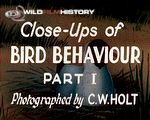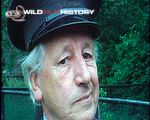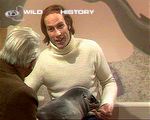![]()

One hundred milestones defining the development of wildlife filmmaking.
| Photographer Eadweard Muybridge takes a series of stills, proving all four of a horse's feet leave the ground at one time when it trots. These early 'animal locomotion’ photos are considered by most film historians to be the ‘origins’ of the moving picture. | 1872 | |
| Das Boxende Känguruh premieres at the first public projection of motion pictures in Germany and is one of the earliest examples of animal behaviour on film. | 1895 | |
| Rough Sea at Dover, considered by some to be the first natural history orientated film, premieres to a paying audience in New York City. | 1896 | |
| British Mutoscope and Biograph Company, pioneers of early cinema technology, releases Pelicans at the Zoo | 1897 | |
| The Sea Lions at Home premieres, regarded by many as the first true wildlife film due to is combination of wild animals, natural location and natural behaviour | 1897 | |
| The first British film featuring a staged confrontation between two animals is made by William K. Dickson and features a fight between a tarantula and a scorpion. More... |
1900 | |
| Charles Urban begins the Unseen World series of micro-bioscopic films with Cheese Mites. | 1903 | |
| Oliver Pike's film, In Birdland, thought to be the first British wildlife film, is screened to a public fee-paying audience. | 1907 | |
| Percy Smith's early time-lapse study, The Birth of a Flower, explores a variety of plants as they bloom, causing great excitement among cinemagoers. | 1910 | |
| J. C. Hemment makes what may be the first aerial film of wildlife; filming a flock of wild ducks. | 1911 | |
| Percy Smith's The Strength and Agility of Insects premieres showing insects lifting objects many times their size and weight. | 1911 | |
| Terrors of the Deep, one of the earliest underwater motion pictures, is produced by Ernest Williamson. | 1914 | |
| Inauguration of British Instructional Films' Secrets of Nature, with The Cuckoo's Secret shown as the first in a series which ran for 11 years. | 1922 | |
| Martin and Osa Johnson's film, Simba, is released with large scale success in American cinemas. The film follows the couple armed with both rifle and camera, as they explore the African sub-continent in search of its wildlife. | 1928 | |
| Cherry Kearton appears in front of the camera in his film, Dassan: An Adventure in Search of Laughter Featuring Nature’s Greatest Little Comedians. | 1930 | |
| Congorilla by Martin and Osa Johnson is touted as the "first sound from darkest" Africa | 1932 | |
| Cinematograph Films (Animals) Act passed in Britain to prevent cruelty to animals in films. | 1937 | |
| The British film, The Private Life of the Gannets, is the first wildlife film to receive an Academy Award for Best One Reel Short Subject. | 1937 | |
| Pirsch Unter Wasser follows Hans Hass as he explores life in a Caribbean coral reef and is one of the first underwater films to gain wide public attention. | 1940 | |
| Hans Hass pioneers the use of self-contained diving equipment with flippers to explore previously inaccessible cave environments in his film Men Among Sharks. | 1942 | |
| Marlin Perkins appears on early US TV (Chicago WBKB) in a series of programmes featuring zoo animals and thought to be the first wildlife television programme anywhere in the world. | 1945 | |
| The first of Disney's True Life Adventures, Seal Island, is released with anthropomorphic tendencies. | 1948 | |
| The Royal Society for the Protection of Birds (RSPB) begins filming birds as part of its efforts to protect them. The silent films are intended as lecture accompaniments. More... |
1950 | |
| In Under the Red Sea, Hans and Lotte Hass explore a wealth of marine behaviour never captured before, including the first pictures of a whale shark underwater and the film wins first prize at Venice for feature-length documentary. | 1951 | |
| Jacques Cousteau begins his career as a broadcaster and film producer and launches his famous research vessel Calypso. | 1951 | |
| Jacques Cousteau takes the first underwater colour footage whilst researching in the Red Sea. | 1952 | |
| David Attenborough's first television series featuring animals, The Pattern of Animals, airs on BBC. | 1953 | |
| Disney's first feature-length True Life Adventure, The Living Desert, premieres. | 1953 | |
| RSPB Film Unit formed. | 1953 | |
| The first outside broadcast, Severn Wildfowl, is filmed at Slimbridge with Peter Scott. | 1953 | |
| Wild Geese with Peter Scott, the first of a series of monthly wildlife programmes begins. | 1953 | |
| Armand and Michaela Denis make their first appearance on British TV with their glamorous travelogue, Filming Wild Animals. | 1954 | |
| Zoo Quest with David Attenborough airs on BBC. | 1954 | |
| Diving to Adventure with Hans and Lotte Hass premieres on the BBC. | 1955 | |
| Heinz Sielmann's Woodpeckers, with its pioneering filming techniques and never before seen footage from within woodpecker nest holes, is shown as part of the BBC's Look series. | 1955 | |
| Look, a regular wildlife series featuring Peter Scott premieres on the BBC with Heinz Sielmann's film Foxes. More... |
1955 | |
| Second series of David Attenborough's Zoo Quest airs. | 1955 | |
| Bernard Grzimek's releases his film, Kein Platz für wilde Tiere, which severely criticizes safari hunting and is regarded as one of the first conservation films. | 1956 | |
| Desmond Morris presents Zoo Time, a children's TV series and the first natural history programming on ITV | 1956 | |
| BBC Natural History Unit established. | 1957 | |
| James Fisher presents A Visit to Hagenbeck's Zoo, the first BBC NHU Eurovision outside broadcast | 1957 | |
| On Safari, with Armand and Michaela Denis, premieres on the BBC. | 1958 | |
| The Undersea World of Adventure, with Hans and Lotte Hass, premieres on the BBC. | 1958 | |
| Tony Soper produces the BBC's first full length wildlife film, The Fulmar | 1958 | |
| White Wilderness, a Disney True Life Adventure, featuring the infamous faked lemming 'suicide', wins an Academy Award for Best Documentary Feature. | 1958 | |
| Serengeti Shall Not Die is awarded an Academy Award for Best Documentary Feature. | 1959 | |
| Countryman featuring Aubrey Buxton airs on Anglia TV. | 1960 | |
| Gerald Thompson engineers innovative lighting systems to deal with his microscopic subjects in The Alder Woodwasp and its Insect Enemies. | 1960 | |
| Survival Anglia is established by Colin Willock and Aubrey Buxton. | 1961 | |
| Survival's SOS Rhino premieres, thought to be one of the earliest examples of a conservation film. | 1961 | |
| The London Scene, the first Survival production airs | 1961 | |
| The Unknown Forest premieres on the BBC, featuring intimate footage of badgers, foxes and fallow deer captured using Eric Ashby's invention of a home-made sound-proof box, the 'blimp'. | 1961 | |
| The first Animal Magic with Johnny Morris airs. | 1962 | |
| The Major is the first BBC Natural History Unit (NHU) production to be filmed in colour. | 1963 | |
| Miss Goodall and the Wild Chimpanzees, filmed by Hugo Van Lawick is the first National Geographic Television programme about wildlife and is shown on CBS. | 1965 | |
| Born Free, a feature film based on Joy Adamson's book, brings wide popular attention to the plight of lions in Africa. | 1966 | |
| The Undersea World of Jacques Cousteau premieres on Australian TV network ABC. | 1966 | |
| The Private Life of the Kingfisher is the first BBC production to be transmitted in colour. | 1967 | |
| The World About Us strand premieres on BBC2. | 1967 | |
| Oxford Scientific Films is founded by Gerald Thompson, David Thompson, Peter Parks, John Paling and Sean Morris. | 1968 | |
| Signals for Survival, featuring Niko Tinbergen, airs on the BBC's World About Us strand exploring in great detail the behaviour of a single species; the lesser black-backed gull. | 1968 | |
| Survival's The Enchanted Isles, is the first British natural history film to air on American network television. | 1968 | |
| Des and Jen Bartlett's The Incredible Flight of the Snow Geese airs on American TV and wins two Emmys. | 1973 | |
| Alan and Joan Root capture unique footage of wildebeest migration using cameras housed in tortoise shells in The Year of the Wildebeest. | 1974 | |
| Partridge Films is founded by Michael Rosenberg. | 1974 | |
| Survival's The Family that Lives with Elephants is broadcast on American TV after a brief copulation scene is removed. | 1974 | |
| Badger Watch premieres, pioneering the 'live' wildlife format. | 1977 | |
| Wildlife on One premieres on BBC1. | 1977 | |
| David Attenborough's legendary encounter with a family of mountain gorillas is a highlight of Life on Earth | 1979 | |
| Life on Earth, the BBC Natural History Unit's first mega-series, airs on BBC2. | 1979 | |
| Animals in Action, Survival's wildlife programme for children, premieres with host Keith Shackleton. | 1980 | |
| The BBC Natural History Unit's second mega-series, The Living Planet, premieres. | 1982 | |
| The first Wildscreen Festival, co-founded by Chris Parsons and Peter Scott | 1982 | |
| BBC2's longest running series, The Natural World, premieres. | 1984 | |
| Discovery Channel premieres on cable in the US. | 1985 | |
| BBC's childrens' wildlife programme, Really Wild Show, premieres on BBC. | 1986 | |
| In-Flight Movie, featuring innovative on-board cameras gives a unique insight into ornithological flight. | 1987 | |
| Meerkats United airs, and is later voted the best wildlife documentary of all time by BBC viewers | 1987 | |
| Supersense, widely acclaimed for its stunning special effects and innovative filming techniques, premieres. | 1988 | |
| Tony Soper and Martha Holmes present Reefwatch, the first ever live underwater broadcast. | 1988 | |
| David Attenborough's The Trials of Life premieres. | 1990 | |
| Jackson Hole Wildlife Film Festival founded. | 1991 | |
| Mountain Gorilla directed by Adrian Warren is the first wildlife film made for IMAX. | 1992 | |
| Echo of the Elephants - Cynthia Moss follows the trials and tribulations of an new born elephant called Echo | 1993 | |
| Private Life of Plants airs on BBC TV. | 1995 | |
| Animal Planet cable channel is launched. | 1996 | |
| Mara Nights uses starlight cameras to reveal nocturnal animal behaviour. | 1996 | |
| Big Cat Diary inaugurates the 'diary' model. | 1997 | |
| National Geographic Channel (NGC) is launched. | 1997 | |
| Steve Irwin makes his first UK TV appearance on The Ten Deadliest Snakes in the World with Steve Irwin. | 1998 | |
| Walking with Dinosaurs uses blue-chip wildlife filmmaking techniques to present a hypothetical view of the natural world during the age of the dinosaurs. | 1999 | |
| Predators: The Ultimate Killing Machines uses miniaturised cameras mounted on the hunters themselves to show the chase from the predators' perspective. | 2000 | |
| The Blue Planet, the first comprehensive series concerning the natural history of the oceans airs. | 2001 | |
| March of the Penguins feature film is distributed in theatres and achieves international success. | 2005 | |
| Soap opera styled Meerkat Manor watched by more than 20 million people in the US alone, premieres on BBC TV. | 2005 | |
| Springwatch premieres on BBC TV with nightly live broadcasts and encourages the public to record sightings of key British species via the website. | 2005 | |
| Extinct airs on ITV, with celebrities highlighting the plight of some of the world's most endangered species and a public phone vote to decide which project received the funds raised. | 2006 | |
| Planet Earth, the BBC's most ambitious mega-series, filmed in HD, premieres. Alastair Fothergill |
2006 | |
| Saving Planet Earth airs on BBC TV. | 2007 | |
| David Attenborough completes his 'Life' series with Life in Cold Blood | 2008 |







